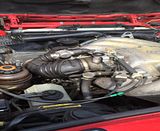I'm at a loss here. The other night I was warming up the car with the fog lights on and the headlights on. I noticed the headlights flicker as I was standing in front of the car and then the car died. I attempted to restart it and the battery was dead... Odd.
I recharged the battery and had it tested, and it's good. I popped the battery back into the car and noticed that the starter turns over very slowly the first few seconds. After the initial slow revolutions of the starter, the starter turns over normally and starts the car. Evry time I try to start the car, the starter is behaving the exact same way.
The other issue is that the alternator is not charging the battery.
Could this be a grounding problem or did the starter and alternator both decide to get sick at the same time very suddenly?
I recharged the battery and had it tested, and it's good. I popped the battery back into the car and noticed that the starter turns over very slowly the first few seconds. After the initial slow revolutions of the starter, the starter turns over normally and starts the car. Evry time I try to start the car, the starter is behaving the exact same way.
The other issue is that the alternator is not charging the battery.
Could this be a grounding problem or did the starter and alternator both decide to get sick at the same time very suddenly?






Comment